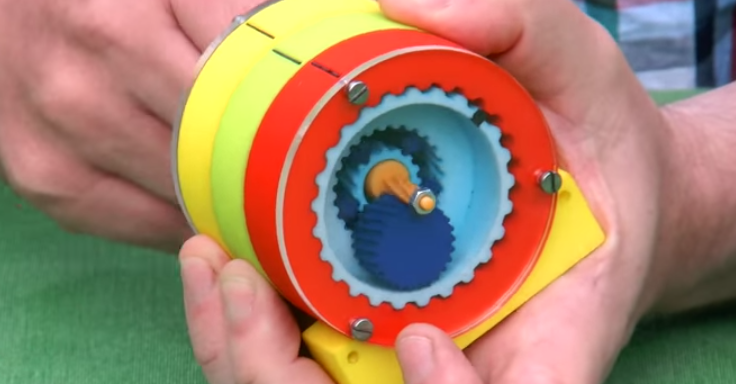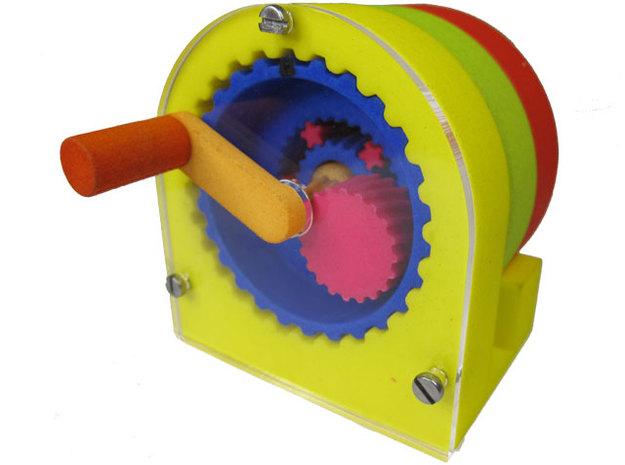
Whether you are an engineer, maker, or both–or just learning–you are going to find M. Oskar van Deventer’s 3D printed extreme reduction device to be impressive–and maybe a little puzzling, too.
While we’ve reported on students creating gears for engineering classes and similar mechanisms for different fun projects like 3D printed toy car kits and sci-fi replicas, van Deventer puts the ‘extreme’ title in his project quite credibly with a gearing that offers reduction of one by eleven million. In simple terms that means for an engineering component, it would offer the ability to create exponential force–by eleven million times–or, to be exact–11,373,076.
As we check out the colorful, coaxial work that appears simple on first glance but actually involves the extreme and complex coordination of integrated parts, it’s not surprising for us to learn that it’s the creation of a talented and experienced puzzle maker. Van Deventer is also a longstanding member of Shapeways whom we’ve reported on before due to his variety of original puzzle mechanisms and expansive storefront and inventory of other items like his famous ‘Over the Top’ Rubik’s Cube, which won a spot in the Guinness World Book of Records for being the largest of its kind in existence.
 Van Deventer’s incredibly cerebral constructions–sometimes commissioned by likeminded individuals–are often meant for the puzzle hobbyist and collector to enjoy and can sometimes cost his fan base well over a thousand dollars.
Van Deventer’s incredibly cerebral constructions–sometimes commissioned by likeminded individuals–are often meant for the puzzle hobbyist and collector to enjoy and can sometimes cost his fan base well over a thousand dollars.
This latest work, retailing at $308.82, is also one that offers a puzzle-like construction but offers possible potential in real-life applications as well. We see that in using even just a fraction of the power the mechanism could perhaps provide use in robotics, for parts in CNC machines or 3D printers, scientific tools, and small motors needed to handle large mechanical loads.
The multi-colored, 3D printed device is compact, with separate gears designated by the multi-colored design skipping a ‘tooth’ with each turn. With a crank and planetary gears built into the first gear or ring, it works to drive the next ring, which moves in the opposite direction. This means that the green ring is moving forward, and the red ring is moving backward, almost at the exactly the same speed, with the net effect being a one to eleven million gearing ratio due to an algorithm developed by van Deventer.
“After a lot of turning, you will see that things have moved,” says van Deventer.
Not much though. With hundreds of turns, you will see that the green ring has moved minimally, and the red ring has moved slightly in the other direction.
 For the mathematically inclined, here are some example gear ratios of the Extreme Reduction device:
For the mathematically inclined, here are some example gear ratios of the Extreme Reduction device:
- Teeth = 4, gear ratio = 2.185
- Teeth = 9, gear ratio = 87.220
- Teeth = 16, gear ratio = 1.322.209
- Teeth = 25, gear ratio = 11.373.076
- Teeth = 36, gear ratio = 67.320.649
- Teeth = 49, gear ratio = 305.880.100
- Teeth = 64, gear ratio = 1.141.624.705
“You have to believe the mathematics–or turn it even more and more to make it even visible. What’s special about this is that it’s an extreme gearing reduction,” says van Deventer. “If I were to do the same thing with worm wheels, and the same size gears, the thing would be much bigger. So, we have a very, very compact and very extreme gearing ratio.”
While many may fail to see the point of this 3D printed device, it offers great potential in concept and as a prototype, as well as fitting right into van Deventer’s ever-growing catalog of often whimsical yet mathematical puzzles and works. Should this interest you, you can take a closer look or purchase it your own 3D printed gear kit at Shapeways–as well as taking at a look at some of the ratios and mathematical calculations. Purchase of the fully-assembled Extreme Reduction device and van Deventer’s other designs is also possible here.
As for the true and immediate purpose of the device, van Deventer leaves that up to you. Do you have any ideas as to how this could make real-world impacts? Is this a 3D printed device you’d like to order for yourself, or even try to emulate with your own 3D printer? Discuss in the 3D Printed Extreme Reduction Device forum thread over at 3DPB.com.

Subscribe to Our Email Newsletter
Stay up-to-date on all the latest news from the 3D printing industry and receive information and offers from third party vendors.
Print Services
Upload your 3D Models and get them printed quickly and efficiently.
You May Also Like
3D Printing News Briefs, July 2, 2025: Copper Alloys, Defense Manufacturing, & More
We’re starting off with metals in today’s 3D Printing News Briefs, as Farsoon has unveiled a large-scale AM solution for copper alloys, and Meltio used its wire-laser metal solution to...
3DPOD 260: John Hart on VulcanForms, MIT, Desktop Metal and More
John Hart is a Professor at MIT; he´s also the director of the Laboratory for Manufacturing and Productivity as well as the director of the Center for Advanced Production Technologies....
3D Printing News Briefs, June 28, 2025: Defense Accelerator, Surgical Models, & More
In this weekend’s 3D Printing News Briefs, 3YOURMIND was selected to join an EU Defense Accelerator, and PTC has announced model-based definition (MBD) capabilities within Onshape. Finally, a study out...
EOS in India: AM’s Rising Star
EOS is doubling down on India. With a growing base of aerospace startups, new government policies, and a massive engineering workforce, India is quickly becoming one of the most important...

































